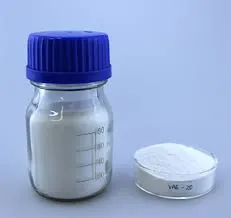
Июл . 26, 2024 11:11 Back to list
HEC
HEC
Feature
- HEC dissolves readily in both cold water and hot water.
- Aqueous solutions of HEC are stable and do not gel at either high or low temperatures.
- HEC is a nonionic cellulose ether that remains chemically and physically stable over a wide pH range.
- HEC shows excellent performance as athickener, as a water-retention agent, as a suspending and dispersing agent, and as a protective colloid.
- HEC can be stored for log periods without degrading significantly, and in aqueous solutions its viscosity remains stable.
HEC (hydroxyethylcellulose) is a water-soluble polymer synthesized by the reaction of ethylene oxide with cellulose.
Aqueous solutions of HEC have excellent characterisstics for applications as thickeners, water-retention agents, suspending and dispersing agents, and as protective colloids.
In the synthesis of hydroxyethylcellulose, the avarage number of moles of ethylene oxide that combines with each mole of cellulose (MS) is used as an index.
The value of MS in HEC is controlled within 1.5 to 2.5.
HEC
Applications
- Water-based paint
- Polymerization
- Cosmetics
- Others
Properties of Aqueous Solutions
1. Concentration and Viscosity
The aqueous solution viscosity of HEC increases rapidly as its concentration increases.
By selecting the grade and concentration of the aqueous solution, an aqueous solution with the desired viscosity can be adjusted.
2. Shear Rate and Viscosity
An aqueous solution of HEC is a non-Newtonian fluid, and its viscosity changes as the shear rate changes.
The viscosity increases as the shear rate decreases, while the viscosity decreases as the shear rate increases (thixotropy).
The thixotropy of an aqueous solution of HEC increases with higher viscosity products with higher molecular weight, and decreases with lower viscosity products. Low-viscosity products have very low thixotropy and exhibit characteristics similar to Newtonian fluids.
Dissolution Speed
HEC is available in two types: normal type and improved solubility type.
The normal type has a high dissolution rate and can be added to water with stirring to quickly prepare an aqueous solution.
The improved solubility type has a lower dissolution rate and improved dispersibility in water by surface treatment. It prevents powder clumping during aqueous solution preparation.
The "F" at the end of the brand name and the CF grade correspond to the solubility improvement type.
Method for Dissolving HEC
It is recommended that the following procedures be used for preparing aqueous solutions.
- Water must be thoroughly agitated, and HEC should be added to the water gradually to prevent lumps from being allowed to form in the water.
- Addition of HEC should be completed before the rise in viscosity of the solution begins.
- Agitation should be continued until the added HEC is completely dissolved.
Dissolving HEC can be made even easier by applying either one of the methods described below.
- HEC is wetted with a water-compatible alcojol before being added to the water.
- HEC is blended with another powder which is either immiscible with, or has a low solubility in water.
The improved solubility type (grades ending in F and CF grades) disperses in water once it is added, and then gradually begins to dissolve, thereby preventing the formation of powder clumps and making it easy to prepare aqueous solutions.
-
Versatile Hpmc Uses in Different Industries
NewsJun.19,2025
-
Redispersible Powder's Role in Enhancing Durability of Construction Products
NewsJun.19,2025
-
Hydroxyethyl Cellulose Applications Driving Green Industrial Processes
NewsJun.19,2025
-
Exploring Different Redispersible Polymer Powder
NewsJun.19,2025
-
Choosing the Right Mortar Bonding Agent
NewsJun.19,2025
-
Applications and Significance of China Hpmc in Modern Industries
NewsJun.19,2025








